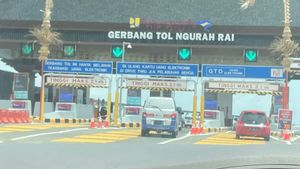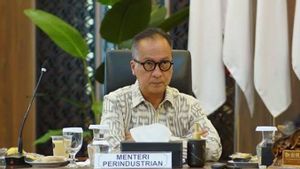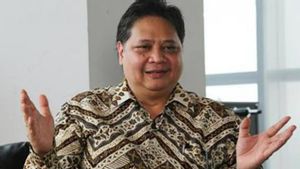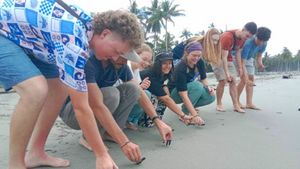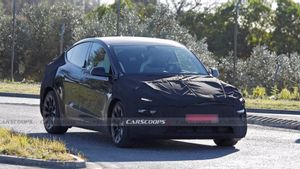JAKARTA - Selective Catalytic Reduction (SCR) technology and the use of green ammonia primary energy are options that are currently being developed to reduce carbon emissions in Steam Power Plants (PLTU). This technology, which has the potential to be used in several coal-fired power plants, is part of the effort to decarbonize the coal combustion process.
For this reason, PT Prima Layanan Nasional Enjiniring and PT Indo Raya Tenaga (IRT) agreed to enter into an MoU "Join Study co-firing of 60 Percent Green Ammonia at SCR-equipped USC Power Plant of PLTU Jawa 9&10". The signing of this agreement was carried out on the sidelines of the B20 series in Nusa Dua Bali, Monday, November 14.
Hartarto Wibowo, Director of Corporate Planning & Business Development at PLN, said that the collaboration between PT Prima Layanan Nasional Enjiniring, a subsidiary of PLN, and IRT as the developer of the PLTU Jawa 9&10, is aimed at the possibility of using green ammonia primary energy as fuel for PLTU as much as 60 percent because PLTU Jawa 9&10 is already equipped with SCR technology.
"We hope that the study will produce something extraordinary. And this will be our way to make the coal power plant more environmentally friendly", he said.
According to him, the feasibility study can be completed within the next three months. After that, the results can be presented to the Directorate General of New, Renewable Energy and Energy Conservation (EBTKE), the Ministry of Energy and Resources (ESDM).
"This is all for a more renewable life", he exclaimed.
On the same occasion, Director General of EBTKE Dadan Kusdiana said, so far there have been strong efforts from both the government and PLN in decarbonizing the PLTU. What the managers of PLTU Jawa 9&10 have done with SCR technology that uses 'green ammonia' is an option that is being seriously studied. He hopes that this study will also be carried out soon.
"There is nothing wrong with coal because as a product it is useful. What we avoid is that coal ends up with CO2. Therefore, we have to find ways to reduce or absorb emissions", he said.
The most practical way may be to replace the coal power plant.
"But there are assets and all economic values. That's why we think about the path of decarbonization. If this (MoU) leads to hydrogen and ammonia, I think this is a smart way", he said.
Dadan emphasized that the government is currently actively encouraging various efforts and studies to implement a zero carbon emission policy or Net Zero Emissions (NZE).
"We are pursuing all alternatives, the direction is how we reduce CO2. In the end, there is no CO2 coming out", said Dadan.
PLTU Jawa 9&10 Most Ready
For your information, Indonesia is indeed actively promoting the transition to renewable energy. If the management and sustainability of the source are available, then blue and green ammonia can be one part of the journey toward the transition to renewable energy, as an alternative source of clean energy for coal-fired power plants.
Combustion of ammonia in a steam furnace, will not produce carbon emissions, but the combustion still emits greenhouse gas emissions in the form of nitrogen oxides.
In response, Selective Catalytic Reduction (SCR) is a proven technology for reducing nitrogen oxides and nitrogen dioxide, by converting their molecules to water and free nitrogen.
Using CSR in PLTU, together with a low Nox burner will significantly reduce the levels of nitrogen oxides and nitrogen dioxide. This will therefore open up the possibility of co-firing much more green ammonia than coal in coal-fired power plants.
SEE ALSO:
To note, PLTU Jawa 9&10 is an award-winning Ultra Super Critical generator as the only power plant in Indonesia. This PLTU installs the most complete emission control equipment with Flue Gas Desulfurization, Electro-Static Precipitator, Low NOx burner, and Selective Catalytic Reduction.
"Why do we want to use SCR, because we want to be different from the others. So the PLTU that uses Ultra Super-Critical USC technology and also SCR, yes, only one, namely PLTU Jawa 9&10", said President Director of PT Indo Raya Tenaga (IRT), Peter Wijaya.
With this joint study, IRT said, PLTU Jawa 9&10 will be ready for significant green ammonia co-firing when and if PLN directives on alternative fuel sources become available in the future.
"Our target is we are ready, so if PLNE wants to transition coal energy to green ammonia, this PLTU is ready", he added.
As the only power plant in Indonesia currently equipped with Selective Catalytic Reduction, PLTU Jawa 9&10 conducted a joint study with PLN in the context of the possibility of co-firing 60 percent green ammonia with 40 percent coal.
PLTU Jawa 9&10 itself has been funded by a project finance scheme since November 2020 and is sponsored by 51 percent by the PLN Indonesia Power group, 34 percent by the Barito Pacific group, and 15 percent by the Kepco group. The BOOT project is made bankable through a 25-year PPA that does not require government guarantees.
In October 2022, PLTU Jawa 9&10 reached an EPC rate of 81 percent and is expected to be commissioned in the last quarter of 2024 and will be COD in the second quarter of 2025.
The English, Chinese, Japanese, Arabic, and French versions are automatically generated by the AI. So there may still be inaccuracies in translating, please always see Indonesian as our main language. (system supported by DigitalSiber.id)





